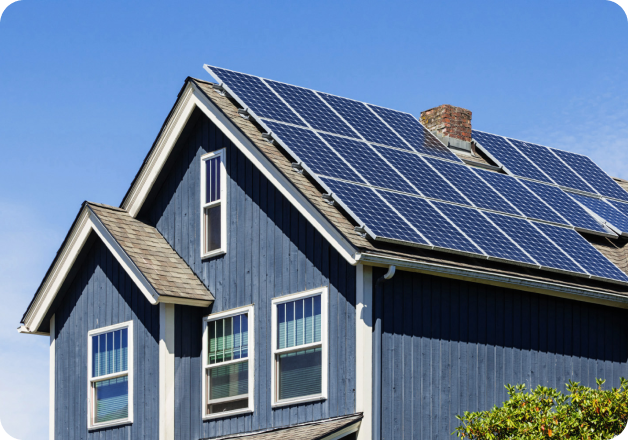Bridging Solar Equity
SolarWiki is dedicated to promoting social justice and economic empowerment through solar energy. We provide information to empower underserved communities, including low-income families and retirees, by highlighting the benefits of solar and showcasing initiatives that make it accessible to all.

Benefits that Come with Adopting Solar
Reduced Energy Bills
Installing solar panels can drastically cut your monthly electricity bills. By generating your own clean energy, you’ll rely less on the grid and save money. The amount saved depends on your solar system’s size, energy use, and local electricity rates. In some cases, you might even sell excess power back to the grid for credits.
Long-term Savings
Solar panels are built to last, with a typical lifespan of 25-30 years. However, they don’t just stop working after this period. Instead, their energy production gradually decreases over time, similar to how your smartphone’s battery life declines with age. So, even after their estimated lifespan, solar panels continue to function and generate electricity, albeit at a slightly reduced capacity.
Predictable Energy Costs
Solar energy provides a stable and predictable source of electricity because you know exactly where it’s coming from. Your roof! This will better manage your budget and take control of costs from the utility company.
Low Maintenance
Solar panels are designed to be low-maintenance, allowing you to enjoy the benefits of clean energy without the hassle of frequent upkeep. Built to withstand various weather conditions, solar panels rarely require repairs or cleaning. In most cases, rainwater will naturally wash away any dirt or debris that accumulates on the surface.
Government Initiatives
Various incentives, such as tax credits, grants, and rebates, can help make solar power more attainable for underserved segments. These financial perks can significantly reduce the upfront cost of installing solar panels, making it easier for families on a tight budget to invest in clean energy.
Environmental Benefits
Solar energy is clean and renewable, helping you reduce the carbon footprint and combat climate change. Moreover, generating your own electricity reduces reliance on the grid and fossil fuels, providing security and self-sufficiency.
Success Story
Kathy Bigler, a homeowner in Sacramento, faced significant challenges and increasing living expenses after her husband passed away.
However, she found support through a collaboration between GRID Alternatives and the Sacramento Municipal Utilities District (SMUD), which connected her with their no-cost solar program for income-eligible homeowners. In January 2024, GRID installed a free rooftop solar system on Kathy’s home, consisting of a 7.315 kw-DC solar array, an EV charger, and a battery system.
This comprehensive triple-impact system is projected to save Kathy more than $1,000 per year, with an anticipated total savings of $24,265 over the system’s lifespan. Kathy intends to use the money saved on her utility bills for other essential expenses and to invest in her family’s well-being.

“Kathy’s story is just one example of how many low-income and underserved families are already benefiting from solar energy”

Olivia Anderson
SolarWiki manager
According to a report by the National Renewable Energy Laboratory (NREL), as of 2022, over 1 million low-income households in the United States had installed solar systems, representing a significant increase from previous years.
This trend is expected to continue as more organizations, like GRID Alternatives, work to make solar energy accessible and affordable for all. By providing no-cost or low-cost solar installations, these programs are helping families reduce their energy bills, improve their quality of life, and contribute to a cleaner, more sustainable future.
Where Should You Start?
Check your eligibility
Research low-income solar programs in your area and see if you qualify based on your household income and other requirements.
Get an energy audit
Many low-income solar programs offer free energy audits to help you find ways to make your home more energy-efficient before installing solar panels.
Explore financing options
Look into government incentives, grants, and special financing options that can help cover the cost of solar installation for low-income households.
Choose a reputable installer
Work with a certified, experienced solar installer who participates in low-income solar programs and understands your specific needs.
Apply for the program
Once you’ve found a program that fits your needs, submit an application and provide the necessary documentation to verify your eligibility.
Schedule your installation
After you’re approved, your solar installer will work with you to schedule a convenient time for the installation process.
Enjoy the benefits
Once your solar panels are installed, you can start enjoying lower electricity bills and the satisfaction of using clean, renewable energy.
Also, don’t forget to check out our SolarWiki Knowledge base to find information on major solar questions you might have.
It’s a great resource to help you understand more about solar energy and how it can benefit you. Remember, every low-income solar program is different, so be sure to research the specific requirements and steps for the programs available in your area.

Ready to Go Solar?
Take control of your energy costs – request solar quotes now.
Overcoming Barriers and Expanding Access in Low-Income Communities
A lot of people in the U.S. could benefit from solar power, especially those who don’t earn a high income. A recent study found that almost half of the country’s population is considered low-income, which means around 49.8 million households.

What’s even better is that about half of these low-income families live in homes that are perfect for installing solar panels.
This is a huge chance for the government and solar companies to create special programs that make it easier and more affordable for these families to switch to clean energy. By focusing on helping low-income households go solar, we could make a big difference in a lot of people’s lives.
Across the United States, there is a growing interest in implementing large-scale policies to enable solar access for low-income families. This interest can be attributed to several factors, including:
- Successful early policy initiatives in California that have demonstrated the feasibility and benefits of low-income solar programs.
- National leadership from the Federal government in promoting solar access for low-income households.
- Increased public awareness of the unique combination of public policy issues that low-income solar can address, such as energy affordability, job creation, and environmental justice.
More and more people are becoming interested in making solar power available to low-income families. This gives decision-makers and leaders a special chance to come up with good plans that can help millions of families across the country enjoy the benefits of clean energy.
Tips for Low-Income Solar Adoption
If you’re a low-income family looking to save money by going solar, here are some key strategies to consider
Net metering
Look for net metering programs that let you get full credit for extra solar power you produce and send to the grid.
Upfront Cost Reduction
Find rebates and incentives that lower upfront installation costs, so you can start saving on energy bills right away.
Consumer Protection
Avoid scams and predatory loans by choosing solar programs with strong consumer protections.
Sustainable Funding
Opt for solar initiatives with reliable, long-term funding to ensure ongoing savings and support.
Accessible Financing
See if the program offers easy payment plans like on-bill financing to make solar more affordable.
Flexible Eligibility
Check eligibility requirements, as some low-income solar programs don’t have strict credit score minimums.
Complementary Programs
Combine solar with energy efficiency upgrades through complementary programs to maximize savings and benefits.






